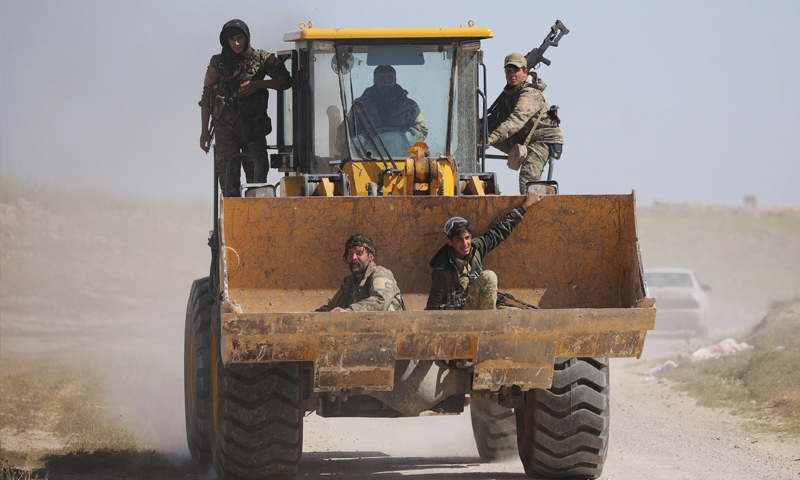October 2019 is proving to be a difficult month for the Syrian Democratic Forces (SDF). Ten days into the month, the SDF faces a decisive battle against the Turkish Army and the National Army (NA) factions. The battle is part of the large military operation encompassing the length of the Syrian-Turkish border announced by Turkey under the name ‘Peace Springs’.
The SDF had been fighting the Islamic State (ISIS) until recently. They declared the ultimate defeat of ISIS in March 2019. Now, the SDF’s guns turn to the border with Turkey.
There is an anticipation of what the following days will bring. Turkey has entered the operation with a fully equipped military on the ground, supported from the air by ongoing strikes against border regions including Ras al-Ayn and Tel Abyad and their vicinity.
The Turkish forces and the NA had announced that they gained control of several areas in the vicinity of Tel Abyad and Ras al-Ayn in northern Syria. However, this was denied by the SDF, who declared that they successfully repelled all incursions.
Who is the SDF?
Formed in October 2015, the SDF remains the military arm of the self-declared Autonomous Administration in northeast Syria. The SDF receives military assistance from the International Coalition led by the United States.
The Kurdish “People’s Protection Units” (YPG) forms the military backbone of the SDF. At its establishment, the SDF was declared “a national unified military force for all Syrians and includes Arabs, Kurds, Syriacs and all other components.”
Before the establishment of the SDF, at the time when large swathes of northern and eastern Syria were under the control of the Islamic State (ISIS), the YPG was organized into small fighting units, mirroring the early days of the Free Syrian Army (FSA). During the siege of Ayn al-Arab (Kobanî), the YPG reached mutually-beneficial alliances with several other factions to repel the ISIS attack on the city.
The YPG emerged publicly in July 2012, a year after the Syrian revolution, and became a de-facto military group active in Hasaka, Aleppo, and Raqqa where it established checkpoints.
The YPG continued as units without a centralized military structure until the period following the siege of Kobanî. The following stage required a more elaborate organization and hierarchical structure to respond to the expanding front on the ground.
This new phase included the establishment of the SDF following the U.S. declaration of its intention to provide select military groups with weapons in order to combat ISIS.
Members of the SDF
On its founding, the SDF included the following factions: “Syrian Arab Coalition”, “Army of Revolutionaries”, “Euphrates Volcano Command Center”, “Sanadid Forces”, “Coalition of Jazira Brigades”, “Syriac Military Council”, “People’s Protection Units” (YPG) and the “Women’s Protection Units” (YPJ).
The founding factions were already organized as military units. This organization allowed the SDF to take control on the ground and to conduct military operations on several fronts in the battle against ISIS.
The former spokesperson of the SDF, Talal Selo, who later defected from the group, declared that the force counted around 50,000 male and female fighters. 70% of this fighting force came from the YPG and the YPJ, while the remaining percentage was encompassed by the rest of the factions.
As for the Turkmen component, Selo explained that it was “a small faction under my leadership, based at the village of Hammam al-Turkmen and counted around 65 fighters. The PKK leadership, especially Shahin Jelo (Ferhad Abdi Shahin), suggested that we should use a name for symbolic reasons only.”
The Syriac Military Council currently includes 50 members. The Arab component, according to Selo, had a large number of fighters but has not recently participated in military operations.
Changes and reorganization
In May 2017, following large-scale military operations by the SDF, the group announced the formation of military regiments in its areas of control.
The co-president of the “Defense and Self-Protection Committee” in the Jazira region, Rezan Kelo, declared in May 2017 that “the goal of establishing the military regiments of the self-defense forces is to build a highly trained and disciplined military force to defend the gains made in Rojava thanks to the sacrifices of thousands of martyrs.”
The first military regiment was announced on 9 May 2017. Kelo said at the time that “those joining the military regiments will receive military and intellectual education to equip them with the necessary skills.”
“These forces are organized under the democratic Autonomous Administration,” Kelo added.
The conditions to join the regiments specify that fighters need to enjoy good health and be aged between 18-40 years old.
The period of service is 23 months, and those serving in these regiments are exempted from the normal military conscription. The members receive certain benefits including health insurance and a monthly stipend of 200 USD.
The hierarchical structure of the SDF remained thus until the defeat of the Islamic State (ISIS). The SDF then announced the establishment of military councils, following significant shuttle diplomacy by Arab and foreign officials in northern and eastern Syria.
In its announcement, SDF said that the councils are meant to re-establish the organizational structure of its forces and the military formations in the region.
The other goal was to unify all the military and security forces under the umbrella of the military council, “to promote a unified struggle against terrorism and to ground institutional action, by activating military institutions and increasing its representation in the council.”
Geographic distribution
The SDF controls a large area of around 35,000 square kilometers, out of the total territory of Syria, 185,000 square kilometers.
The SDF has recently received heavy weapons from the U.S. including troop carriers, mortars and heavy machine guns as well as ammunition, despite strong opposition from Turkey which considers the PYD as no more than the Syrian offshoot of the Kurdistan Workers’ Party (PKK).
The SDF receives advice from the U.S. military at the battlefronts, as well as aerial support from the U.S. Air Force during battles with the Islamic State (ISIS).

